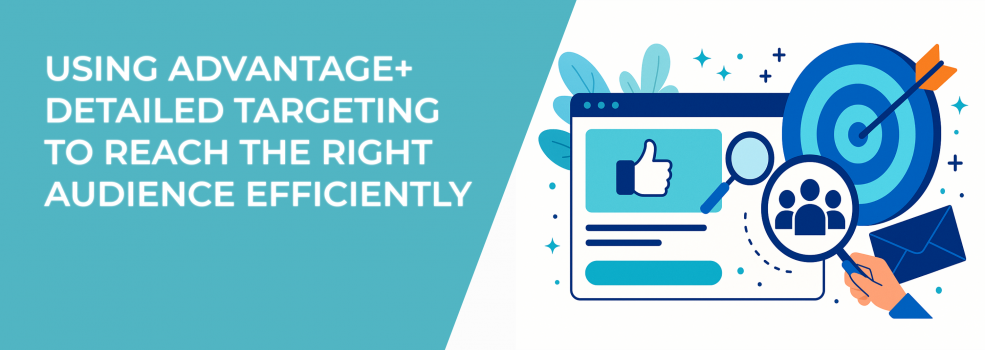The Meta advertising ecosystem has changed dramatically in the last few years. Privacy-first policies, automated ad products, and data loss have all reshaped how advertisers find their ideal audience. If you've been running Facebook or Instagram campaigns, you've probably felt the shift: broader targeting, fewer control levers, and a growing reliance on Meta's algorithms.
But are you really reaching the people who matter?
Enter Advantage+ Detailed Targeting — a feature that blends Meta's automation with your chosen interest signals. On paper, it sounds like the best of both worlds. In practice, it's a tool that requires a bit of finesse, some testing, and a good understanding of how Meta is thinking about ad delivery in 2025.
Let’s explore how you can use it to your advantage and avoid common traps.
What Is Advantage+ Detailed Targeting?
Advantage+ Detailed Targeting is a Meta advertising setting that allows the platform to go beyond your selected interests, behaviors, or demographics when it believes it can get better results elsewhere. It doesn’t ignore your targeting — it just treats it more like a starting point.
Think of it like a smart filter: you give Meta a signal (say, people interested in "yoga" or "vegan recipes") and Meta tests audiences adjacent to those interests if it thinks they’ll drive more conversions.
This is different from traditional targeting, where Meta would stick strictly to your defined parameters. Now, with Advantage+ Detailed Targeting enabled, the algorithm can expand your reach, which can be great — or a bit chaotic — depending on your campaign structure.
Why Meta Introduced It And Why You Should Pay Attention
In a world where pixel data is shakier, third-party insights are drying up, and audiences are increasingly privacy-protected, Meta needs to rely more on its own models. That’s where Advantage+ tools come into play. Meta's goal? Improve ad delivery outcomes using its massive machine learning infrastructure.
But here’s the catch: you’re giving up some control. And for advertisers who care deeply about reaching specific niches or keeping spend tightly focused, that trade-off needs to be navigated carefully.
Still, in many tests, advertisers are seeing lower CPAs and broader reach when using Advantage+ Detailed Targeting.
So, is it worth it? Probably, if you know how to guide it.
If you’re still adjusting your strategy to these shifts, our article on Facebook Ads Targeting Updates: How To Adapt breaks down exactly what’s changed and what to do next.
How to Use It Without Losing Control
Here’s the key: treat Advantage+ Detailed Targeting like a smart assistant, not a magic wand. You still need to define strong initial parameters — interest categories, behaviors, demographics — that anchor Meta’s system in the right direction.
Some practical tips:
-
Start with high-intent signals: Choose interests that strongly correlate with your product or service. Don’t cast a wide net just to let Meta “figure it out.”
-
Use exclusions thoughtfully: You can still exclude certain groups (like existing customers or irrelevant audiences) to prevent waste.
-
Let your creative guide the algorithm: Meta often uses creative signals as part of its delivery logic. If you’re targeting fitness lovers, your ads should look and feel like they’re made for that audience — even if Meta shows them to someone slightly outside the fitness niche.
-
Test toggling Advantage+ on and off: Run A/B tests with identical setups, one with the feature enabled and one without. Don’t assume that automation always wins.
Remember, Meta will prioritize performance over precision unless you structure your campaigns carefully. That means defining your goals — is this campaign about pure scale, or do you need targeted lead quality?
If you're balancing automation with control across your campaigns, read our article Meta Advantage+ or Manual Setup? for more insights.
When Does It Actually Work Best?
Advantage+ Detailed Targeting shines in campaigns optimized for conversions or leads — especially when paired with strong creative and decent event tracking.
Say you're a DTC skincare brand. You target users interested in "clean beauty," "organic skincare," and "cruelty-free products." With Advantage+ on, Meta might also show your ads to users following eco-conscious influencers or engaging with sustainability content — people you didn't target directly, but who may still convert.
It can also help when your initial audience is too narrow. If your interest targeting leads to high CPMs and low delivery, enabling Advantage+ might break the bottleneck. Meta expands your audience just enough to keep the algorithm learning — without blowing up your budget.
On the flip side, if you're running a localized service business or have a niche B2B offer, Advantage+ might muddy the waters. You’ll need tighter targeting and better filtering in those cases.
Not sure which audience signals matter most? Start by learning how to identify high-intent audiences using Facebook Insights.
Should You Rely on It?
Yes, but with eyes open.
Advantage+ Detailed Targeting is not a shortcut. It’s a tool that rewards advertisers who put in the work upfront: smart interest grouping, exclusion logic, conversion-optimized creative, and ongoing testing. If you’re expecting it to do all the thinking for you, you’ll probably be disappointed.
But if you use it to expand smartly, fill in the gaps, and increase efficiency, it can be a powerful layer in your ad strategy.
Final Thoughts
Meta is betting big on automation and advertisers need to adapt, not resist. Advantage+ Detailed Targeting is just one part of a broader shift toward machine-led campaign delivery. And while it’s tempting to chase precision through manual controls, the data shows that flexible targeting can often outperform rigid setups — especially when paired with clear conversion goals.
Still wondering if you should turn it on for your next campaign? Try it, test it, measure results, and see how it plays with your audience.
Because in 2025, efficient targeting isn’t just about who you want to reach — it’s about who Meta knows will convert.

